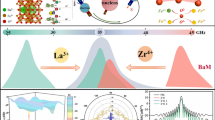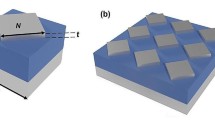Abstract
We have constructed the solar absorber in bloom design in three different layers: the ground layer, substrate layer, and resonator layer. The ground layer uses aluminum (Al), the substrate layer is INDIUM antimonide (InSb), and the bloom resonator is gold (Au). The proposed absorber can be used in the ultraviolet (UV) region, the violet (V) region, the near-infrared (NIR) region, and the middle-infrared (MIR) spectrums. The absorption rate in the UV, V, NIR, and MIR spectrums is 88.8%, 94.2%, 92.8%, and 89.2%, respectively. After final construction, the created structure has an average solar radiation rate of 92% throughout all four zones. At the 800 nm bandwidth, the absorption rate reaches more than 97%, and at the 1500 nm bandwidth, the absorber is above 95%. Step-by-step building and resulting absorption rate (A), reflectance rate (R), and transmittance rate (T) can be explored in each step. The solar radiation with the respective bandwidth range and AM 1.5 situation can be studied. The parameter converting of the ground layer width and ground layer thickness, the substrate layer thickness, and the resonator layer can be studied. Transverse electric mode (TE) and transverse magnetic mode TM can be studied by converting the degrees from 0 to 50° by 10° separation. The quantity of the electric field intensity in color variations can be illustrated. The comparison table of the current absorption rates of the other published works can be presented.










Similar content being viewed by others
Availability of Data and Materials
The data supporting the findings in this work are available from the corresponding author with a reasonable request.
References
Aman MM et al (2015) A review of safety, health and environmental (SHE) issues of solar energy system. Renew Sustain Energy Rev 41:1190–1204. https://doi.org/10.1016/j.rser.2014.08.086
Rabaia MKH et al (2021) Environmental impacts of solar energy systems: a review. Sci Total Environ 754. https://doi.org/10.1016/j.scitotenv.2020.141989
Al-Othman A et al (2022) Artificial intelligence and numerical models in hybrid renewable energy systems with fuel cells: advances and prospects. Energy Convers Manag 253. https://doi.org/10.1016/j.enconman.2021.115154
Camacho EF, Berenguel M (2012) Control of solar energy systems. In IFAC Proceedings Volumes (IFAC-PapersOnline) 8(1):848–855. https://doi.org/10.3182/20120710-4-SG-2026.00181
Kalogirou SA (2015) Building integration of solar renewable energy systems towards zero or nearly zero energy buildings. Int J Low-Carbon Technol 10(4):379–385. https://doi.org/10.1093/ijlct/ctt071
Kabeel AE, Mečárik K (1998) Shape optimization for absorber plates of solar air collectors. Renew Energy 13(1):121–131. https://doi.org/10.1016/S0960-1481(97)00034-7
Tripanagnostopoulos Y, Souliotis M, Nousia T (2000) Solar collectors with colored absorbers. Sol Energy 68(4):343–356. https://doi.org/10.1016/S0038-092X(00)00031-1
Al-Shahri OA et al (2021) Solar photovoltaic energy optimization methods, challenges and issues: a comprehensive review. J Clean Prod 284. https://doi.org/10.1016/j.jclepro.2020.125465
Wang H, Wang L (2013) Perfect selective metamaterial solar absorbers. Opt Express 21(S6):A1078. https://doi.org/10.1364/oe.21.0a1078
Cao F, McEnaney K, Chen G, Ren Z (2014) A review of cermet-based spectrally selective solar absorbers. Energy Environ Sci 7(5):1615–1627. https://doi.org/10.1039/c3ee43825b
He Y, Wang BX, Lou P, Zhu H (2020) Multiple-band absorber enabled by new type of metamaterial resonator formed by metallic split ring embedded with rectangle patch. Results Phys. https://doi.org/10.1016/j.rinp.2020.103251
Patel SK, Charola S, Jani C, Ladumor M, Parmar J, Guo T (2019) Graphene-based highly efficient and broadband solar absorber. Opt Mater (Amst). https://doi.org/10.1016/j.optmat.2019.109330
Mastai Y, Polarz S, Antonietti M (2002) Silica-carbon nanocomposites - a new concept for the design of solar absorbers. Adv Funct Mater 12(3):197–202. https://doi.org/10.1002/1616-3028(200203)12:3%3c197::AID-ADFM197%3e3.0.CO;2-A
(2000) 00/02708 Comparison between predicted and actually observed in-service degradation of a nickel pigmented anodized aluminium absorber coating for solar DHW systems. Fuel Energy Abstr 41(5):301. https://doi.org/10.1016/s0140-6701(00)96621-9
Konttinen P, Lund PD (2004) Microstructural optimization and extended durability studies of low-cost rough graphite-aluminium solar absorber surfaces. Renew Energy 29(6):823–839. https://doi.org/10.1016/j.renene.2003.11.008
Ozgen F, Esen M, Esen H (2009) Experimental investigation of thermal performance of a double-flow solar air heater having aluminium cans. Renew Energy 34(11):2391–2398. https://doi.org/10.1016/j.renene.2009.03.029
Kumar SN, Malhotra LK, Chopra KL (1983) Nickel pigmented anodized aluminium as solar selective absorbers. Sol Energy Mater 7(4):439–452. https://doi.org/10.1016/0165-1633(83)90017-5
Wazwaz A, Salmi J, Bes R (2010) The effects of nickel-pigmented aluminium oxide selective coating over aluminium alloy on the optical properties and thermal efficiency of the selective absorber prepared by alternate and reverse periodic plating technique. Energy Convers Manag 51(8):1679–1683. https://doi.org/10.1016/j.enconman.2009.11.047
Patel SK, Parmar J, Katrodiya D, Nguyen TK, Holdengreber E, Dhasarathan V (2020) Broadband metamaterial-based near-infrared absorber using an array of uniformly placed gold resonators. J Opt Soc Am B. https://doi.org/10.1364/josab.389283
Kim C, Ryu Y, Shin D, Urbas AM, Kim K (2020) Efficient solar steam generation by using metal-versatile hierarchical nanostructures for nickel and gold with aerogel insulator. Appl Surf Sci 517. https://doi.org/10.1016/j.apsusc.2020.146177
O’Neill P, Ignatiev A, Doland C (1978) The dependence of optical properties on the structural composition of solar absorbers: gold black. Sol Energy 21(6):465–468. https://doi.org/10.1016/0038-092X(78)90069-5
Liu J, Fan L, Ku J, Mao L (2016) Absorber: a novel terahertz sensor in the application of substance identification. Opt Quantum Electron 48(2):2–9. https://doi.org/10.1007/s11082-015-0361-5
Srinivasa Rao A, Sakthivel S (2015) A highly thermally stable Mn-Cu-Fe composite oxide based solar selective absorber layer with low thermal loss at high temperature. J Alloys Compd 644:906–915. https://doi.org/10.1016/j.jallcom.2015.05.038
Patel SK, Charola S, Parmar J, Ladumor M, Ngo QM, Dhasarathan V (2020) Broadband and efficient graphene solar absorber using periodical array of C-shaped metasurface. Opt Quantum Electron. https://doi.org/10.1007/s11082-020-02379-5
Parmar J, Patel SK, Katrodiya D, Nguyen TK, Skibina JS, Dhasarathan V (2020) Numerical investigation of gold metasurface based broadband near-infrared and near-visible solar absorber. Phys B Condens Matter 591:412248. https://doi.org/10.1016/j.physb.2020.412248
Parmar J, Patel SK, Katkar V (2022) Graphene-based metasurface solar absorber design with absorption prediction using machine learning. Sci Rep. https://doi.org/10.1038/s41598-022-06687-6
Han BB, Alsalman O, Surve J, Parmar J, Taya S, Patel SK (2023) Compact size Zr–Fe2O3 inspired metal-dielectric angle and polarization insensitive nanostructure for efficient solar energy absorption. Int J Therm Sci 190:108330. https://doi.org/10.1016/j.ijthermalsci.2023.108330
Ferhati H et al (2021) Absorption enhancement in amorphous Si by introducing RF sputtered Ti intermediate layers for photovoltaic applications. Mater Sci Eng B Solid-State Mater Adv Technol 269. https://doi.org/10.1016/j.mseb.2021.115152
Zhu L, Jin Y, Liu H, Liu Y (2020) Ultra-broadband absorber based on metal-insulator-metal four-headed arrow nanostructure. Plasmonics 15(6):2153–2159. https://doi.org/10.1007/s11468-020-01244-1
Mansouri M, Mir A, Farmani A (2022) Design and numerical simulation of a MoS2 plasmonic pressure sensor based on surface plasmon resonance and Fabry-Perot interferometer. Plasmonics 17(6):2375–2384. https://doi.org/10.1007/s11468-022-01722-8
Sassi IA, Ben El Hadj Rhouma M, Daher MG (2023) Highly sensitive refractive index gas sensor using two-dimensional silicon carbide grating based on surface plasmon resonance. Opt Quantum Electron 55:5. https://doi.org/10.1007/s11082-023-04682-3
Zhu D et al (2023) Research on Surface Plasmon Resonance Sensing of Metal Nano hollow Elliptic Cylinder. Plasmonics. https://doi.org/10.1007/s11468-023-01930-w
Beiranvand B, Khabibullin RA, Sobolev AS (2023) Local field enhancement due to the edge states of nanoplasmonic crystal. Photonics 10:3. https://doi.org/10.3390/photonics10030263
Warhurst A (2002) Sustainability indicators and sustainability performance management. Mining, Minerals and Sustainable Development 43:1–129
Lin X et al (2018) Integrative solar absorbers for highly efficient solar steam generation. J Mater Chem A 6(11):4642–4648. https://doi.org/10.1039/c7ta08256h
Liu B et al (2021) Optical properties and thermal stability evaluation of solar absorbers enhanced by nanostructured selective coating films. Powder Technol 377:939–957. https://doi.org/10.1016/j.powtec.2020.09.040
Razak AA et al (2016) Review on matrix thermal absorber designs for solar air collector. Renew Sustain Energy Rev 64:682–693. https://doi.org/10.1016/j.rser.2016.06.015
Liu Z, Liu G, Huang Z, Liu X, Fu G (2018) Ultra-broadband perfect solar absorber by an ultra-thin refractory titanium nitride meta-surface. Sol Energy Mater Sol Cells 179:346–352. https://doi.org/10.1016/j.solmat.2017.12.033
Liu Z, Liu G, Liu X, Wang Y, Fu G (2018) Titanium resonators based ultra-broadband perfect light absorber. Opt Mater (Amst) 83:118–123. https://doi.org/10.1016/j.optmat.2018.06.008
Gao H et al (2018) Refractory ultra-broadband perfect absorber from visible to near-infrared. Nanomaterials 8:12. https://doi.org/10.3390/NANO8121038
Soydan MC, Ghobadi A, Yildirim DU, Erturk VB, Ozbay E (2019) All ceramic-based metal-free ultra-broadband perfect absorber. Plasmonics 14(6):1801–1815. https://doi.org/10.1007/s11468-019-00976-z
Tian X, Li Z-Y (2016) Visible-near infrared ultra-broadband polarization-independent metamaterial perfect absorber involving phase-change materials. Photonics Res 4(4):146. https://doi.org/10.1364/prj.4.000146
Yu P et al (2019) A numerical research of wideband solar absorber based on refractory metal from visible to near infrared. Opt Mater (Amst). https://doi.org/10.1016/j.optmat.2019.109400
Patel SK, Charola S, Jadeja R, Nguyen TK, Dhasarathan V (2021) Wideband graphene-based near-infrared solar absorber using C-shaped rectangular sawtooth metasurface. Phys. E Low-Dimensional Syst. Nanostructures 126:114493. https://doi.org/10.1016/j.physe.2020.114493
Patel SK, Surve J, Jadeja R, Katkar V, Parmar J, Ahmed K (2022) Ultra‐wideband, polarization‐independent, wide‐angle multilayer swastika‐shaped metamaterial solar energy absorber with absorption prediction using machine learning. Adv Theory Simulations 2100604. https://doi.org/10.1002/adts.202100604
Acknowledgements
The authors received funding from the Deanship of Scientific Research at Najran University for under the Research Priorities and Najran Research funding program: grant code NU/NRP/SERC/12/44.
Author information
Authors and Affiliations
Contributions
Conceptualization, AHMA and SKP; methodology, AHMA, SKP; software, AHMA and BBH; validation, AA, SKP, BAA, and SAT; writing—original draft preparation, all authors; writing—review and editing, all Authors; all authors have read and agreed to the published version of the manuscript.
Corresponding authors
Ethics declarations
Ethical Approval
Not applicable.
Competing Interests
The authors declare no competing interests.
Additional information
Publisher's Note
Springer Nature remains neutral with regard to jurisdictional claims in published maps and institutional affiliations.
Rights and permissions
Springer Nature or its licensor (e.g. a society or other partner) holds exclusive rights to this article under a publishing agreement with the author(s) or other rightsholder(s); author self-archiving of the accepted manuscript version of this article is solely governed by the terms of such publishing agreement and applicable law.
About this article
Cite this article
Almawgani, A.H.M., Han, B.B., Patel, S.K. et al. Design of Surface Plasmon Resonance–Based Solar Absorber Using Bloom-Shaped Au-InSb-Al Structure. Plasmonics 19, 631–641 (2024). https://doi.org/10.1007/s11468-023-02003-8
Received:
Accepted:
Published:
Issue Date:
DOI: https://doi.org/10.1007/s11468-023-02003-8




